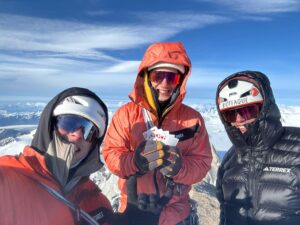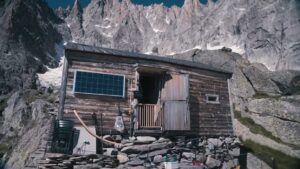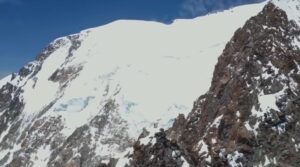BY ALEXANDER HARO
On a Tuesday afternoon in August of 2022, Alex Honnold took the final steps to the top of a previously unclimbed peak in eastern Greenland. Ingmikortilaq, a 3,750-foot sea cliff, is a daunting feature of nature that juts directly up from the freezing waters of Nordvestfjord in the Scoresby Sound. It’s a fantastically beautiful place full of ice-laden waters –- an unforgiving climate battered by howling, freezing winds.
Although Honnold likely subscribes to George Mallory’s “because it is there” climbing mindset, he had another reason to go to the ends of the Earth to embark on the trip: gathering information about an area of the planet that is a canary in the coal mine of the climate crisis. And on Feb. 4, a new three-part miniseries called Arctic Ascent with Alex Honnold that documents the expedition was released.
Honnold was joined by Hazel Findlay and Mikey Shaefer, both of whom are bonafide climbing superstars. The plan was to assist a French glaciologist named Heidi Sevestre with accessing some of the most remote parts of one of the most remote places in the world. They enlisted the help of Greenlandic guide Adam Kjeldsen and adventurer Aldo Kane to do so.
Hard to access
Researchers have long theorized that the area might be less sensitive to climate change because of its altitude. But given how difficult it is to reach those areas, the data supporting the theory was a little thin.
“East Greenland is one of the most remote and least studied parts of the Arctic, which makes it very important scientifically,” Sevestre told National Geographic a few days after they returned. “We desperately need scientific data from this region. Studying the fiords, the glaciers, the ice sheets will bring so much data to the scientific community that the contribution will be extremely positive.”
Honnold is an interesting man. I caught up with him about Arctic Ascent via a Zoom call. He sat in a small room that served as a sparse office he called “his closet.” Just a few images hung on the walls behind him — a map of the world and a few framed photos of mountains — and Honnold spoke to me about doing things that most people would dream of doing in a calm, measured manner that would normally be reserved for a conversation about an afternoon walk in the park.
For the layperson, Ingmikortilaq looks impossibly difficult to climb. And although Honnold is the world’s most accomplished big-wall climber, he too was awed by the majesty of that bare wall of granite.
Fear factor
“I think we’re more similar than you might think,” he told me when I asked him about his motivation and whether he feels frightened before embarking on an attempt like the one in Arctic Ascent. “When I look at something like that, I’m also intimidated by it. We’re sort of awed by it. I mean, I’m an experienced climber, so I see that it’s possible, but I think that for me part of the pleasure is to look at something that seems so daunting like that, and then to actually be able to achieve it.
“You take something that seems impossible and then, through a long period of hard work and effort, make it possible. It’s not like I look at it and am like, ‘Oh, that looks trivial.’ I look at it, I’m like, ‘wow, that’s really intimidating.’ I like finding things that are right in that sweet spot where it’s challenging enough to be daunting, but still possible, hopefully.”
As a relatively new father of a two year old (and a baby on the way), Honnold doesn’t take these trips as lightly as he might’ve in the past. But as the trip came together, he knew it was something he couldn’t miss. Not just because it was a chance to do something no one had ever done before, but because it was a chance to do something far more important than climbing a mountain.
Family leave
“Would it be worth leaving the family for that long just to go climb a wall?” he said. “Maybe. But if you’re with the right people and you’re doing climate science that will then be broadcast on mainstream media, you’re sort of like, ‘oh, that makes it worth it.’ I don’t want to be gone for six weeks just to have fun with my buddy and climb a wall. It has to be worth it. I think making meaningful contributions to climate science and the climate science communication is important. Eastern Greenland is so fragile and so important.”

Photo: National Geographic/Screenshot
Shallow ice cap
Arctic Ascent with Alex Honnold doesn’t only cover the climb of Ingmikortilaq. Just getting to the base was exceedingly difficult. They first needed to get to the Renland Ice Cap, where the movement of the Arctic sea ice has a strong influence on the climatic conditions. Researchers using ice cores from the Renland Ice Cap can look back in time about 100,000 years. And since it’s a relatively shallow ice cap that lacks a brittle ice zone like that of say, the Greenland Ice Sheet, it better allows researchers to look to the past to predict the future.
But to get there, Honnold and the crew first needed to make a 1,500-foot ascent up something called the Pool Wall, then cross the vast, barren expanse of the Renland Ice Cap. Honnold rated the Pool Wall at 5.12c, which is no easy feat even for the most experience climber, weather conditions not withstanding.
“It doesn’t do justice to how mega the wall is,” he said. “It was 20˚F (-6˚C), and we climbed it in a snowstorm.”
Outside comfort zone
Sevestre, the glaciologist with the climbers, was a little nervous. Although she had done some climbing, the Pool Wall was her first real introduction to big-wall climbing. “It was way outside my comfort zone,” she said. “Scientists don’t typically climb big walls.”
Honnold, though, knew she would fare just fine. “She is incredibly fit and incredibly capable,” he told me. “She was actually relatively experienced with rope work, because she’s rappelled in and out of ice caves a lot. She was carrying this tremendously heavy backpack. She had all the scientific equipment and stuff. And she’s just a monster. She’s very strong.”
Even as she gritted her teeth hundreds of feet above the ground, she stopped to take samples of the rock face she clung to. Those samples will help other scientists to understand how fast the ice sheet retreated at the end of the last ice age. That knowledge will in turn help them to make projections relating to future sea level rise as the Greenland Ice Sheet melts.
The Pool Wall was just the beginning. After summiting it, they faced a grueling five-day trek over the Renland Ice Cap, dragging most of the supplies behind them and taking realtime measurements of the snow’s depth and density as they traveled over it. It was new territory for Honnold.
A different, vaster scale
“The whole experience in Greenland was definitely a different scale,” he remembered. “Because the landscape is so vast and we traveled so far across it. Everything was bigger. I think part of the appeal of the expedition was to really experience that landscape.”
Over the course of those days crossing the Renland Ice Cap, Honnold and the rest of the team used a variety of techniques to check in on Greenland’s health. They installed temperature sensors, scanned glaciers with 3D lasers, and even launched a float designed by NASA into the fiord to collect information over the next two years about water temperatures and salinity, both of which are affected by melting ice. And finally, after crossing those grueling miles, they reached their destination — or the bottom of it, at least.
Staring up at Ingmikortilaq, the climbers were struck with the enormity of the task ahead of them. Honnold, who has climbed some of the hardest routes in the world (and famously free soloed Yosemite’s El Capitan), called it “a horrendous, death-defying wall.”
Over the next five days, the expedition team moved fixed ropes up the first half of the wall. Then, over the final two days, Honnold and Findlay pushed hard to reach the top, spending a freezing night on a thin ledge, carrying water and freeze-dried food in their packs as they climbed.
Horrifyingly loose rock
“Hazel and I both thought it was the most serious thing of its kind that we’d ever done,” Honnold told National Geographic as the team was boarding a motorboat for a 20-hour return journey through the ice-choked fiords back to the nearest Inuit village. “To do nearly 4,000 feet of climbing, on horrifyingly loose rock…It felt interminable.”
Arctic Ascent is an important show. It’s much more than entertainment for the sake of entertainment. It packages a message that the whole world needs to hear into a box that even those with only the slightest of interest in the climate crisis will be interested in.
“All people should care what happens in the Arctic, because if the ice melts it will theoretically raise sea levels by up to 20 feet,” Honnold explained. “And that’s a big deal for the several 100 million people that live on coasts around the world. I mean, the biggest mega cities in the world are on the coast. That’s hundreds of millions of people who are affected by what happens in the Arctic.”
We live in a surprisingly fragile world, and our relentless pursuit of convenience is throwing the balance off. It’s easy to ignore it as we bask in the comforts of our ingenuity, but the very lives of future generations depend on change. In order to begin making those necessary changes, we must first be aware of the toll that pursuit is taking on the planet. Arctic Ascent attempts to lay that toll out in no uncertain terms.
More than climbing
“It helps people understand why this matters to the rest of the world,” Honnold said. “I mean, obviously, one TV program isn’t going to change climate policy in any way. On the other hand, compared to everything else that’s on television, I think that this is doing people more of a service than most of TV for sure. If you’re going to go to all the trouble and expense to go to the middle of nowhere, why don’t you have somebody with you who can use that opportunity?
“We were using the opportunity to climb an unclimbed peak, which is cool. But ultimately, that’s not really doing a whole lot of good for the world. It’s important to be able to communicate both those stories to a mainstream audience and hopefully allow people to appreciate the beauty and the fragility of Eastern Greenland. Hopefully, that’s the real service.”
Arctic Ascent with Alex Honnold premiered Feb. 4 on National Geographic and Feb. 5 on Disney+ and Hulu.






